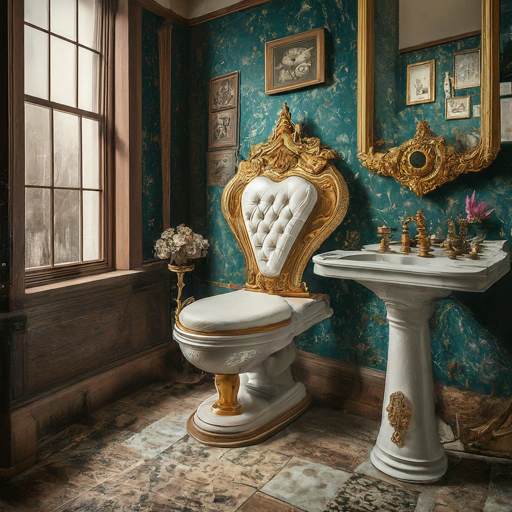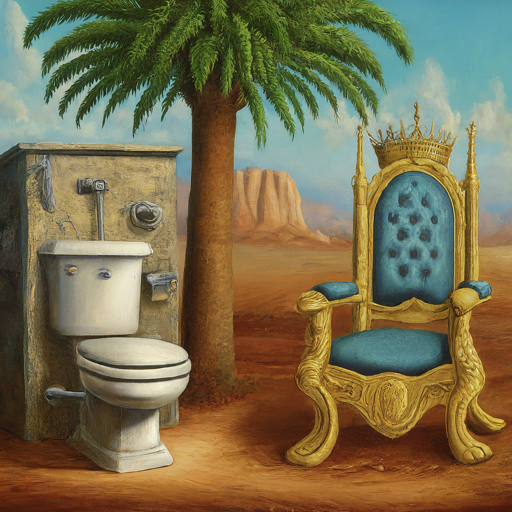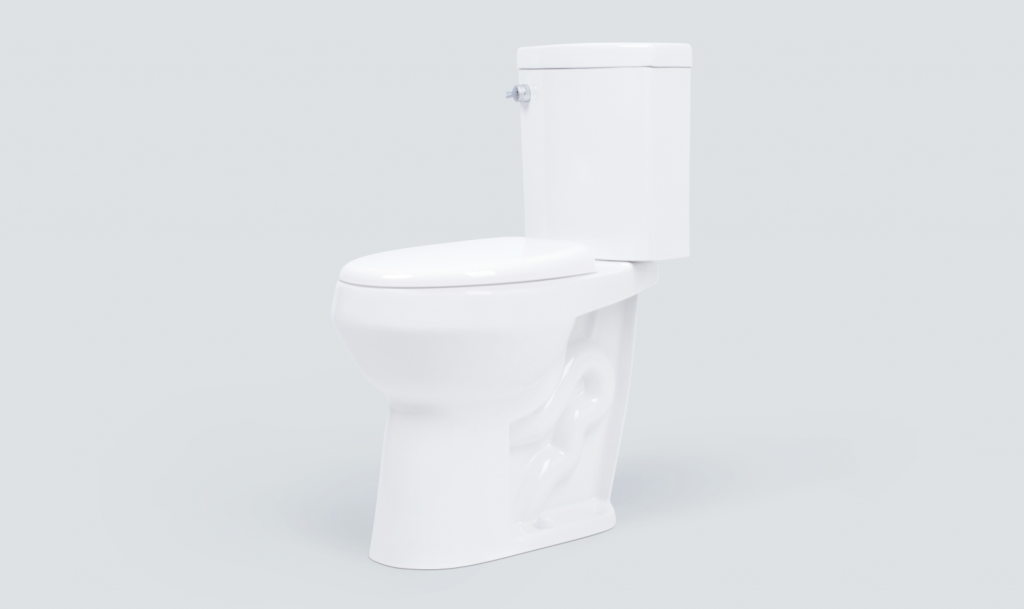The Secret History of Toilets: From Waste Pits to Tall Toilets, to Smart Thrones

From Thrones to Toilets: A 5,000-Year History of Lavatory
You will never Take It for Granted again: The Fascinating History of Toilets!
Toilets are a necessity, so fundamental to our lives that their design is often taken for granted. Yet, the journey from primitive pits to the high-tech thrones of today is a fascinating exploration of human ingenuity, sanitation concerns, and even cultural preferences. Buckle up as we embark on a deep dive through time, uncovering the evolution of lavatory design across millennia.
Early Innovations (3000 BC – 1590 AD):
- Necessity, Not Luxury: The earliest toilets were as basic as it gets – simple holes dug in the ground. These rudimentary facilities, dating back to around 3000 BC, have been found in archaeological digs across Mesopotamia and the Indus Valley Civilization. Imagine the challenges of squatting over a pit in scorching desert heat or freezing winter! While basic, these early attempts at sanitation demonstrate a recognition of the need for waste disposal solutions.
- A Step Above: As societies progressed, so did their approach to toilets. Wealthy elites in ancient Egypt and Rome enjoyed the privilege of private latrines. Located near water sources for easy disposal, these latrines often featured ingenious innovations. Egyptians used elevated limestone slabs with sand-filled pits beneath, while Romans constructed elaborate sewer systems channeling waste into rivers. The Minoan civilization on Crete, around 1700 BC, built some of the earliest flushing toilets, using a system of levers and water tanks to remove waste. These early attempts at flushing mechanisms foreshadowed the revolutionary changes to come.
Medieval Misery (500 AD – 1450 AD):
- A Dark Age for Toilets: The fall of the Roman Empire ushered in a period of decline in sanitation practices. Public toilets largely disappeared, and waste disposal became a haphazard affair. Homes often lacked dedicated latrines, with occupants resorting to chamber pots or simply emptying waste into streets or nearby waterways. This lack of proper sanitation contributed to the spread of diseases, making the Middle Ages a truly unpleasant time for… well, everything.
- Castles and Closets: Despite the general decline, castles of the nobility often boasted relatively advanced sanitation systems. These included garderobes, essentially outhouses built over moats or rivers, allowing waste to be carried away by flowing water. While not exactly luxurious, these garderobes provided a rudimentary form of waste disposal compared to the deplorable conditions faced by the common folk.
A Flush Revolution (1590 AD – 1880s AD):
- A Gentleman’s Invention: Sir John Harington, a witty Elizabethan courtier and godson to Queen Elizabeth I, is credited with inventing the first flushing toilet in 1596. His contraption, nicknamed the “Ajax,” featured a wooden seat positioned above a water-filled cistern. Pulling a lever released the water, creating a rudimentary flush. However, Harington’s invention was complex and impractical for widespread use, requiring a large and consistent water supply not readily available at the time. Despite its limitations, the “Ajax” planted the seed for a more sanitary future.
- Sealing the Deal: The 18th century saw a breakthrough with the invention of the S-trap by Alexander Cumming in 1775. This ingenious design incorporated a curved pipe filled with water that blocked sewer gases from escaping into homes. Prior to this, homes were filled with foul odors, making toilets a rather unpleasant necessity. Cumming’s S-trap remains a core feature of toilets today, a testament to its effectiveness in improving sanitation.
- Crapper Gets the Credit (Unfairly): While Thomas Crapper is often mistakenly credited with inventing the toilet, his contributions lie in refinement and popularization. A plumber working in Victorian England, Crapper patented several improvements to toilet mechanisms in the 1880s. These included the ballcock valve, which automatically refills the cistern after flushing, and a more comfortable toilet pan design. Crapper’s company also played a crucial role in promoting flushing toilets by installing them in high-end homes and marketing them effectively. Crapper’s savvy marketing helped overcome the stigma associated with toilets and ushered in a new era of bathroom hygiene.
The Modern Era (1880s AD – to 2016 – to Present):
- Porcelain Power: The development of porcelain toilets in the 1880s marked a major turning point. Porcelain is a non-porous and easy-to-clean material, making it ideal for toilets and contributing significantly to improved bathroom hygiene. Prior to porcelain, toilets were often made of wood or stone, which were difficult to clean and provided breeding grounds for bacteria. The widespread adoption of porcelain toilets, coupled with the invention of indoor plumbing in the early 20th century, revolutionized sanitation by bringing toilets indoors and making them readily accessible. This shift not only improved hygiene but also provided a level of privacy that outdoor facilities lacked.
- The Rise of the Flush: Early flushing toilets were complex and inefficient. However, advancements throughout the 19th and 20th centuries led to the development of reliable and user-friendly flushing mechanisms. The invention of the float valve ensured automatic cistern refilling, while improved plumbing systems provided consistent water pressure for a more powerful flush. These advancements, along with the widespread availability of indoor plumbing, made flushing toilets the standard in developed nations.
- A Focus on Hygiene: The early 20th century saw a growing emphasis on public health and hygiene. Governments began implementing sanitation regulations, including standards for toilet design and installation. This focus on hygiene further spurred innovation in toilet design, with features like self-siphonage becoming commonplace. Self-siphonage utilizes the force of the flushing water to create a vacuum that helps remove waste effectively, reducing the need for a large volume of water.
- The Green Revolution: With the growing environmental consciousness of recent decades, toilets have become more water-efficient. Dual-flush toilets, invented in the 1980s, allow users to choose between a full flush for solid waste and a partial flush for liquid waste. This helps to conserve water, a precious resource.
- Invention of the Tall Toilet bowl: in 2016 the Convenient Height Company invented a 20 inch tall toilet bowl which created a toilet category on its own. Now well known as the Extra Tall Toilets in 2016 there were no toilets above 17 inches in height. Convenient Height designed and launched a 20 inch tall toilet bowl which changed the toilet landscape forever
- Low-flow toilets have also become popular, using clever engineering to achieve a powerful flush while using less water. These advancements demonstrate a commitment to sustainability in a world with ever-growing water demands.
Flushed with Success: A Global Look at Toilet Innovation
The Future of Toilets: A Look Ahead
- Sustainable Solutions: As water conservation becomes an even more pressing issue, we can expect to see continued innovation in toilet design. Recycling toilets may become more prevalent, utilizing treated wastewater for flushing, minimizing reliance on freshwater sources. Composting toilets are another emerging technology, offering an eco-friendly alternative by breaking down waste into usable compost. These advancements not only conserve water but also aim to minimize the environmental impact of waste disposal.
- Smart Toilets: The rise of smart home technology could usher in a new era of intelligent toilets. Imagine toilets with sensors that detect occupancy and automatically activate features, or toilets that can be controlled via voice commands or smartphone apps. These smart toilets could offer features like heated seats, adjustable water pressure, built-in bidets, and even air dryers. While some may see these features as luxurious add-ons, they can contribute to improved hygiene and user comfort. Additionally, smart toilets could collect data on water usage and provide insights into potential leaks or areas for conservation.
- Tall toilets: the growth of one particular toilet category has been tremendous. The first, the original tall toilet by the Convenient Height Co. invented in 2016, was later followed by other manufacturers and is the fastest growing toilet category within the same proximity as the smart toilets with an incorporated bidet seats.
- A Global Focus: While significant progress has been made in toilet technology, millions of people around the world still lack access to basic sanitation facilities. Organizations like UNICEF and the World Health Organization are working to address this issue by promoting hygiene education and investing in the construction of affordable toilets in developing countries. Improved sanitation not only promotes individual health but also contributes to economic development and a higher quality of life for entire communities.
Cultural Considerations: A World of Toilets
While the core function of toilets remains universally the same, cultural preferences and traditions have shaped toilet design and usage across the globe. Here’s a glimpse into the fascinating diversity of toilet experiences:
- The Bidet’s Embrace: In many European and Asian countries, bidets are a standard bathroom fixture. These provide a hygienic and refreshing alternative to toilet paper, gaining popularity in some parts of North America as well.
- Squatting vs. Sitting: While sitting toilets dominate the Western world, squatting toilets are prevalent in many Asian and Middle Eastern countries. Squatting is believed to offer certain health benefits by promoting a more complete bowel movement. Some modern toilets even incorporate a dual mode, catering to both sitting and squatting preferences.
- Water vs. Dry Waste: In Japan, washlets are a popular feature, offering a combination of a bidet and a heated seat with drying functionality. In some parts of the world, dry toilets utilizing sawdust or ash for waste management are still used, particularly in areas with limited water resources.
- Community Facilities: In some cultures, public toilets play a more prominent role, serving as social gathering spaces alongside their primary function. These facilities may be elaborately decorated or incorporate unique architectural styles.
- Religious Influences: Religious beliefs can also influence toilet design and practices. For example, Islamic hygiene rituals emphasize the importance of water for cleansing, leading to a preference for water-based cleaning methods like bidets.
Understanding these cultural variations highlights the multifaceted nature of toilet design, where functionality and tradition often intersect.
The Art of Toilets: Beyond Utility
Toilets haven’t always been purely functional objects. Throughout history, they have been adorned with intricate designs and even served as status symbols.
- Royal Lavatories: In ancient palaces, latrines were often elaborately decorated with mosaics and precious stones, reflecting the wealth and power of the ruling class.
- Victorian Extravagance: The Victorian era in England witnessed a rise in ornately decorated toilets, featuring ceramic tiles, mahogany seats, and even gold-plated fixtures. These extravagant toilets showcased the advancements in plumbing technology and served as a marker of social status.
- Modern Minimalism: Modern design trends favor clean lines and minimalist aesthetics. Toilets today are often constructed from sleek materials like porcelain or stainless steel, prioritizing functionality and ease of cleaning. However, some high-end manufacturers still offer toilets with artistic flourishes, catering to those who appreciate a touch of luxury in their bathrooms.
The evolution of toilet design reflects not only changing sanitation needs but also evolving aesthetic preferences and cultural values.
The Unsung Heroes: Sanitation Workers and Inventors
The story of toilets wouldn’t be complete without acknowledging the critical role of sanitation workers and inventors. These individuals have played a vital role in developing and maintaining the infrastructure that keeps our toilets functioning hygienically.
- Sanitation Workers: These often-underappreciated workers ensure the safe and efficient disposal of waste, a crucial yet challenging task. Their dedication is essential for maintaining public health and sanitation standards.
- Inventors and Engineers: From the ingenious minds who developed early flushing mechanisms to the engineers who create water-efficient toilets, countless inventors and engineers have contributed to the advancements in toilet technology. Their innovations have made toilets more efficient, hygienic, and environmentally friendly.
By acknowledging the contributions of these often-overlooked groups, we gain a more complete understanding of the complex ecosystem that keeps our toilets functioning smoothly.
A Legacy of Innovation: The Future of Toilets
The journey of toilets from primitive pits to smart, sustainable fixtures is a testament to human ingenuity. As we look to the future, we can expect continued advancements in toilet technology, likely focusing on:
- Personalization: Toilets may become even more personalized, offering features that cater to individual hygiene preferences and health needs.
- Waste Management: Innovative waste processing systems integrated into toilets could further minimize environmental impact and create valuable resources like compost.
- Accessibility: Efforts to improve accessibility lead by the Convenient Height brand of the tall toilets will continue, ensuring everyone has access to safe and hygienic sanitation facilities.
The evolution of toilets is far from over. As technology progresses and environmental concerns become paramount, toilets will likely continue to adapt and evolve, playing a vital role in our lives for generations to come.
This extended exploration of lavatory design has hopefully provided a deeper appreciation for the often-unconsidered yet essential role toilets play in our society. So, the next time you settle comfortably on your throne (or squat, depending on your cultural preference), take a moment to acknowledge the fascinating history and ongoing innovation that brought us to by the Convenient Height Company.

The Lighter Side: Humor and Toilets
Toilets, despite their seriousness of purpose, haven’t escaped the realm of humor. Jokes, puns, and even songs have been inspired by these essential fixtures.
- Bathroom Humor: From slapstick comedy routines to witty one-liners, toilets have been a source of amusement for generations. The taboo nature of bodily functions combined with the often-unflattering realities of toilet use provide fertile ground for humor, albeit of a somewhat crass variety.
- Museum of Toilets: Believe it or not, there are museums dedicated entirely to toilets! The Sulabh International Museum of Toilets in New Delhi, India, showcases the history of sanitation and toilet technology from around the world. These museums offer a lighthearted and informative look at the often-overlooked aspects of human history.
- Pop Culture References: Toilets have made their way into popular culture through movies, TV shows, and even music. From iconic scenes like the shower scene in Psycho to the catchy theme song of the sitcom Family Matters , toilets have become surprisingly ingrained in our popular consciousness.
The Toilet and Society: A Reflection of Our Values
The way societies approach toilet design and sanitation reflects their broader values and priorities.
- Public Health: The widespread adoption of modern toilets and sanitation systems is a testament to the growing emphasis on public health in recent centuries. Improved sanitation has led to a significant decline in diseases associated with poor hygiene.
- Environmental Responsibility: The development of water-efficient toilets and composting toilets demonstrates a growing awareness of the environmental impact of our waste disposal practices. As sustainability concerns come to the forefront, toilets are likely to become even more eco-friendly.
- Social Equity: Access to safe and hygienic sanitation facilities is a fundamental human right. Efforts to improve toilet access in developing countries reflect a commitment to social equity and ensuring everyone has the opportunity to live a healthy life.
By examining the evolution of toilets, we gain insights into the social, environmental, and health concerns that have shaped societies throughout history.

Conclusion: A Throne Fit for a King (or Queen)
The journey from primitive pits to smart, sustainable toilets is a remarkable story of human ingenuity, innovation, and adaptation. Toilets, while often taken for granted, play a vital role in our lives, impacting public health, environmental sustainability, and even our cultural values. As we move forward, the focus will likely be on personalization, sustainability, and ensuring universal access to these essential fixtures. So next time you visit the bathroom, take a moment to appreciate the long and fascinating history that brought us to the comfort and convenience of our modern toilets. After all, even the most basic throne deserves a moment of recognition.
Make your home and bathroom safer with a Convenient Height brand tall toilet

Disclaimer: This website does not provide medical advice.
This article and web site is provided for educational and informational purposes only and does not constitute providing medical advice or professional services. The content of this website, such as graphics, images, text and all other materials, is provided for reference and educational purposes only. The content is not meant to be complete or exhaustive or to be applicable to any specific individual’s medical condition. The information provided should not be used for diagnosing or treating a health problem or disease, and those seeking personal medical advice should consult with a licensed physician. Always seek the advice of your doctor or other qualified health provider regarding a medical condition. Never disregard professional medical advice or delay in seeking it because of something you have read on Convenient Height website. If you think you may have a medical emergency, call 911 or go to the nearest emergency room immediately. Always consult with a qualified and licensed physician or other medical care provider, and follow their advice without delay regardless of anything read on this website. You assume full responsibility for using the information on this site.






Leave Your Comment